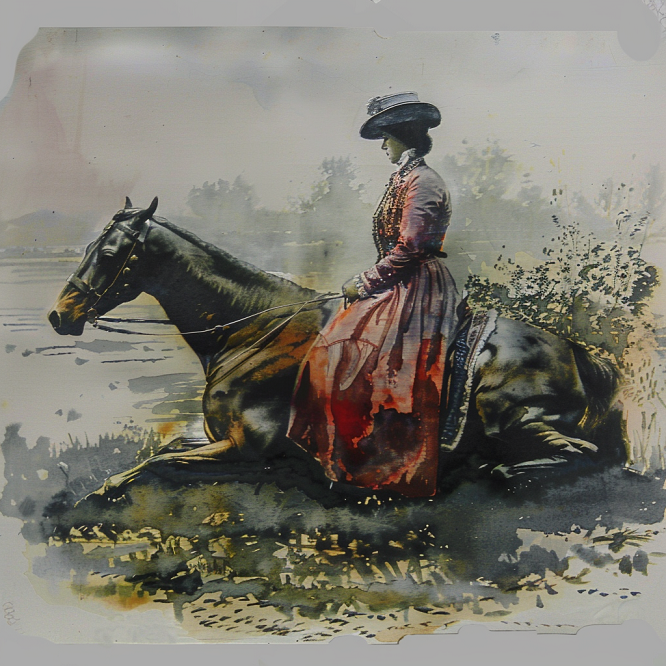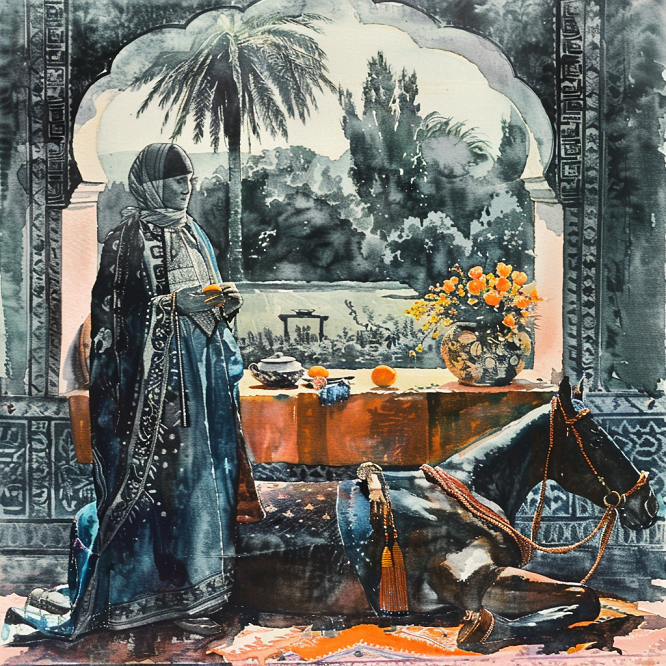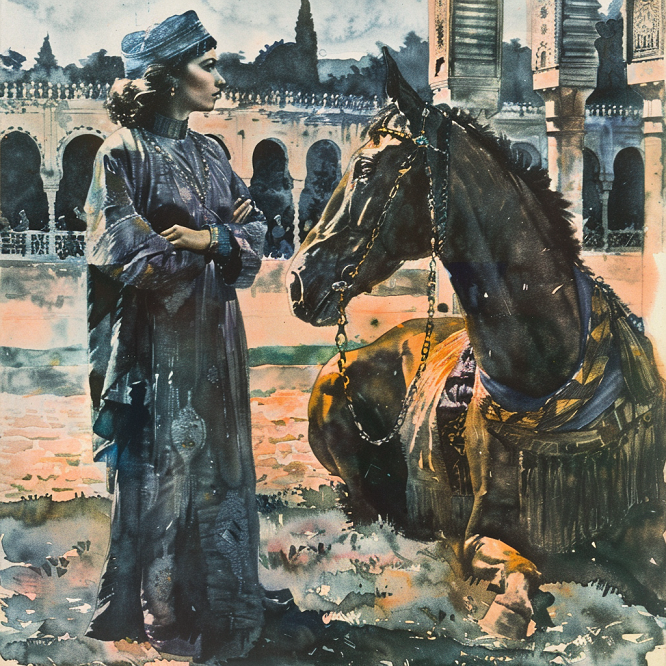Lady Anne Blunt’s life was an extraordinary journey through the Victorian era, marked by her deep passion for exploration, scholarly pursuits, and her distinguished aristocratic background. As the granddaughter of the legendary poet Lord Byron, she grew up surrounded by the arts, literature, and an enduring quest for knowledge. Together with her husband Wilfrid Scawen Blunt, her travels throughout the Middle East were not just adventures but a mission to immerse themselves in Arabian cultures, understand the majestic landscapes, and appreciate the noble Arabian horse.
Through her landmark works, “Bedouin Tribes of the Euphrates” and “A Pilgrimage to Nejd,” Lady Anne offers a richly detailed glimpse into the lives of the Bedouin tribes such as the Shammar and Anizzah. Her writing brings to life the geographies of places like Riyadh and Ha’il, providing precious insights into their ways of life. This essay celebrates Lady Anne Blunt’s incredible journey from the comfort of British high society to the deserts of the Arabian Peninsula. We explore her profound impact on cultural and geographical studies, her literary legacy, and the lasting imprint she left on the world through her explorations and writings.
Early Life
Lady Anne Blunt, born into the upper tiers of British aristocracy, grew up in a world where education, art, and the humanities were highly valued. Her early years were filled with rigorous intellectual development and a strong immersion in the arts, shaping the multifaceted talents and deep curiosity that would hallmark her later endeavors. Gifted in Arabic, a skill few of her peers possessed, and with accomplishments in music and art, Lady Anne’s abilities were as broad as they were deep.
Her marriage to Wilfrid Scawen Blunt, a poet and political activist, brought together two individuals with a shared deep love for the Middle East and its cultures. Their travels together went beyond mere sightseeing; they were heartfelt quests to grasp the rich and complex life in the Middle East, its people, and its landscapes.
During the Victorian era, a time when the Orient fascinated many and imperial ambitions were high, Lady Anne and Wilfrid set out on their journeys. Yet, their aim was different from that of many contemporaries. They sought not to exert dominance or to romanticize but to truly understand and record the essence of what they encountered. This period also saw significant geopolitical interest in the Middle East, a complex scene the Blunts navigated with both scholarly interest and diplomatic skill.
Lady Anne Blunt’s travels were endeavours to shed light on an unknown culture, presenting the Middle East in a light that was empathetic, respectful, and richly informed. Her contributions not only enriched understanding but also laid a groundwork for future scholarly work, fostering a more informed and respectful exchange between East and West.

Books Authored By Lady Anne Blunt:
“Bedouin Tribes of the Euphrates” (First published in 1879)
“Bedouin Tribes of the Euphrates,” first published in 1879, is a pioneering book by Lady Anne Blunt that delves into the lives of the nomadic cultures thriving along the vast stretches of the Euphrates River. This work is celebrated for its thorough exploration of the Bedouin tribes, especially the Shammar and Anizzah, shedding light on their social organization, traditions, and the intricacies of their everyday lives. Lady Anne’s unique approach of integrating herself into these communities allowed her to capture their existence through the lens of someone who lived it, making her findings deeply authentic compared to the more detached observations of her peers.
Her vivid portrayal of the Shammar tribe, key players in the regional socio-political arena, and the Anizzah tribe, distinguished for their skill in breeding the finest Arabian horses, paints a dynamic picture of Bedouin life. The book’s insights into tribal leadership, social norms, and economic practices, such as the trade of livestock, offer a holistic view of Bedouin culture.
When “Bedouin Tribes of the Euphrates” was released, it was immediately recognized for its depth of understanding and precise depiction. Lady Anne Blunt’s contribution went far beyond anthropology; she provided a richly layered perspective on Middle Eastern cultures, challenging the simplistic Orientalist views of her era. The significance of her work transcends its initial acclaim, becoming an essential reference for scholars and enthusiasts in Middle Eastern studies and anthropology across generations.
“A Pilgrimage to Nejd” (First published in 1881)
In “A Pilgrimage to Nejd,” Lady Anne Blunt takes us on an exhilarating adventure into the Arabian Peninsula’s heart, a place that, at the time, was a mystery to the Western world. This journey wasn’t just any trip; it was a bold quest to chart the uncharted lands of Nejd and to bring back purebred Arabian horses for their Crabbet Arabian Stud. This expedition in the early 1870s became a highlight of Lady Anne’s adventurous life, despite the daunting challenges of the desert’s extreme conditions and navigating through a maze of tribal politics.
With her evocative storytelling, Lady Anne brings to life the cities of Riyadh and Ha’il, offering one of the West’s first intimate glances at these remote areas. Her writings shed light on the architectural wonders, the vibrant culture, and the social intricacies of these regions, sharing a side of Arabian life previously unknown to her contemporaries. Her keen observations on local governance, especially the insightful look at Ha’il under Ibn Rashid’s rule, are particularly noteworthy for their depth and contribution to our understanding of the region’s political landscape.
The impact of “A Pilgrimage to Nejd” goes far beyond its rich cultural and geographical explorations. This work significantly broadened Western understanding of Arabian geography and was instrumental in fostering a deep appreciation for the Arabian horse’s heritage. Lady Anne’s journey, captured with her meticulous attention to detail and deep respect for the cultures she encountered, not only widened the map of the Arabian Peninsula but also paved the way for future research and exploration in the area.
“A Pilgrimage to Nejd” cements Lady Anne Blunt’s legacy as not just an intrepid explorer but as a cultural ambassador, weaving a story that captivated both academics and adventure lovers alike. Her work stands as a pillar in Middle Eastern studies, treasured for its vivid detail, scholarly depth, and the unstoppable spirit of adventure that propelled Lady Anne across the Arabian deserts.

Themes & Motifs in Anne Blunt’s Writings
Diving into Lady Anne Blunt’s literary world, you’re swept into a vivid journey that weaves together her own incredible adventures with broader stories of society, culture, and geography. Her masterpieces, especially “Bedouin Tribes of the Euphrates” and “A Pilgrimage to Nejd,” offer deep dives into the heart of the Middle East, brimming with exploration, adventure, and a keen insight into its rich cultural and geographical fabric.
What sets Lady Anne’s work apart is her genuine respect and curiosity for the cultures she encounters. Breaking away from the era’s common Orientalist views, she looked at the Middle Eastern cultures with fresh eyes, eager for true cultural exchange and understanding. This shines through in her detailed observations of Bedouin customs, social setups, and everyday life, captured with the precision of an ethnographer and the awe of a true explorer.
Lady Anne also carved out a unique space for women in the realms of exploration and literature at a time when society had rigid expectations. Her bold expeditions and scholarly endeavors defy the norms, telling a powerful story of female empowerment and intellectual autonomy. Her contributions challenge and expand the narrative about women’s roles in academia and adventure, areas once reserved for men.
Her reflections on the political and social intricacies of the places she visited also offer a thoughtful critique of imperialism. Through her eyes, we get a glimpse into the tangled web of tribal allegiances, colonial ambitions, and the enduring spirit of local cultures, offering a different perspective from the dominant imperial narrative of her time.
Lady Anne Blunt’s writings are a treasure trove that enriches our comprehension of the Middle East and provides a captivating look at the interplay of culture, gender, and politics in the Victorian era. Her legacy is more than just a collection of travel logs; it’s a beacon of exploration, showcasing the timeless importance of crossing cultural boundaries with respect and open-mindedness.
Impact & Legacy
Lady Anne Blunt’s adventures and her meticulous documentation have carved a permanent niche in Middle Eastern studies, geography, and the lore of the Arabian horse. Her seminal works, notably “Bedouin Tribes of the Euphrates” and “A Pilgrimage to Nejd,” have gone far beyond their original reception, becoming cornerstone texts that fuel ongoing research, fuel wanderlust, and captivate horse lovers around the globe.
Her contributions have profoundly shaped our understanding of the Middle East. With keen ethnographic insights and rich, firsthand accounts, Lady Anne provided a fresh lens through which Western scholars could view and appreciate the cultural and geographical tapestries of the Arabian Peninsula. Her narratives have added layers of depth and complexity to our discourse on this captivating region.
Moreover, Lady Anne’s passion for Arabian horses and her efforts to preserve their lineage through the establishment of the Crabbet Arabian Stud, alongside her husband, have left a mark on the world of equine studies and horse breeding. The legacy of their work, ensuring the survival and purity of these majestic animals, continues to resonate in today’s equestrian circles, where Crabbet bloodlines are treasured for their elegance, speed, and stamina.
But Lady Anne’s impact stretches beyond her scholarly and equestrian achievements. By stepping into the male-dominated arenas of exploration and academic research, she not only challenged but also changed the gender norms of her era. As a woman who navigated the intricate socio-political terrains of the Middle East during the Victorian period, her success is a powerful statement on the indispensable contributions of women to history, scholarship, and literature.
Lady Anne Blunt’s legacy is rich and diverse, spanning across the understanding of a region, the preservation of a noble horse breed, and the breaking of gender boundaries. Her life and body of work continue to inspire and enlighten, embodying the timeless virtues of curiosity, determination, and a profound respect for cultures different from our own.

Conclusion
Lady Anne Blunt’s adventures and her writings have woven a rich legacy that deeply enhances our grasp of Middle Eastern cultures, the breathtaking landscapes, and the noble Arabian horse. Her keen eye for detail and thoughtful analysis in gems like “Bedouin Tribes of the Euphrates” and “A Pilgrimage to Nejd” have made lasting marks on anthropology, geography, and the study of horses. But there’s so much more to her story. Lady Anne lived a life that broke the mold, challenging the gender expectations of her time with courage and grace. She’s become a beacon of inspiration for countless women who dare to explore, write, and break barriers in their own rights.
Her legacy is defined by an immense respect for the cultures she immersed herself in and a tireless commitment to her research and adventures. Today, her work continues to echo in the ongoing study of the places she held dear. Lady Anne Blunt stands as a symbol of intellectual curiosity and a bridge between cultures, her contributions a testament to the power of understanding and the importance of building connections across the world.

